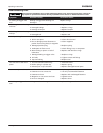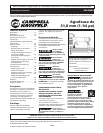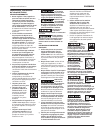
3
Operating Instructions SN338K00
www.chpower.com
for use with this tool by the tool
manufacturer are able to result in
a risk of injury to persons or tool
damage when used in this tool.
i. Selecting an appropriate tool
actuation system, taking into
consideration the work application
for which the tool is used.
Never use
gasoline
or other fl ammable liquids
to clean the tool. Never use
the tool in the presence of
fl ammable liquids or gases. Vapors
could ignite by a spark and cause an
explosion which will result in death or
serious personal injury.
Do
not
remove, tamper with,
or otherwise cause the
trigger lock or trigger
to become inoperable.
Do not operate any
tool which has been modifi ed in a like
fashion. Death or serious personal
injury could result.
Do
not
touch the trigger unless
driving fasteners. Never
attach air line to tool or
carry tool while touching the trigger.
The tool could eject a fastener which
will result in death or serious personal
injury. Also actuate the trigger lock to
the safe position when not in use.
Always disconnect the
tool from the power
source when unattended, performing
any maintenance or repair, clearing
a jam, or moving the tool to a new
location. Do not load the tool with
fasteners when the trigger is depressed.
The tool could eject a fastener causing
death or serious personal injury.
Always fi t tool with a
fi tting or hose coupling
on or near the tool in
such a manner that all
compressed air in the tool is discharged
at the time the fi tting or hose coupling
is disconnected. Do not use a check
valve or any other fi tting which allows
air to remain in the tool. Death or
serious personal injury could occur.
Never
place
hands or any other body
parts in the fastener
discharge area of the tool.
The tool might eject a fastener and
could result in death or serious personal
injury.
PERSONAL SAFETY
a. Stay alert. Watch what you are
doing and use common sense
when operating the tool. Do not
use the tool while tired or under
the influence of drugs, alcohol,
or medication. A moment of
inattention while operating the
tool increases the risk of injury to
persons.
b. Dress properly. Do not wear loose
clothing or jewelry. Contain long
hair. Keep hair, clothing, and
gloves away from moving parts.
Loose clothes, jewelry, or long
hair increases the risk of injury to
persons as a result of being caught
in moving parts.
c. Avoid unintentional starting.
Be sure the switch is off before
connecting to the air supply. Do not
carry the tool with your finger on
the switch or connect the tool to the
air supply with the switch on.
d. Do not overreach. Keep proper
footing and balance at all times.
Proper footing and balance enables
better control of the tool in
unexpected situations.
e. Use safety equipment. A dust mask,
non-skid safety shoes and a hard
hat must be used for the applicable
conditions.
f. Always wear eye
protection.
g. Always wear hearing
protection when using
the tool. Prolonged
exposure to high intensity
noise is able to cause
hearing loss.
h. Do not attach the hose or tool to
your body. Attach the hose to the
structure to reduce the risk of loss of
balance if the hose shifts.
i. Always assume that the tool
contains fasteners. Do not point
the tool toward yourself or anyone
whether it contains fasteners or not.
j.
Do not nail on
top of another
nail. This is able to cause the nail to
be deflected and hit someone, or
cause the tool to react and result in a
risk of injury to persons.
k. Remove finger
from the trigger
when not driving fasteners. Never
carry the tool with finger on trigger,
the tool is able to fire a fastener.
Always remain in a
fi rmly balanced
position when using or handling the
tool.
Avoid long extended
periods of work
with the tool. Stop using the tool if you
feel pain in hands or arms.
TOOL USE AND CARE
a. Use clamps or another practical way
to secure and support the workpiece
to a stable platform. Holding the
work by hand or against the body is
unstable and is able to lead to loss
of control.
b. Do not force the tool. Use the
correct tool for the application. The
correct tool will do the job better
and safer at the rate for which the
tool is designed.
c. Do not use the tool if the switch
does not turn the tool on or off. Any
tool that cannot be controlled with
the switch is dangerous and must be
repaired.
d.
Disconnect the
tool from the air
source before making adjustments,
doing tool maintenance, clearing
jams, leaving work area,loading,
or unloading the tool. Such
precautionary measures reduce the
risk of injury to persons.
e. Store the tool when it is idle out
of reach of children and other
untrained persons. A tool is
dangerous in the hands of untrained
users.
f. Maintain the tool with care. Keep
a cutting tool sharp and clean. A
properly maintained tool, with sharp
cutting edges reduces the risk of
binding and is easier to control.
g. Check for misalignment or binding
of moving parts, breakage of parts,
and any other condition that affects
the tool’s operation. If damaged,
have the tool serviced before using.
Many accidents are caused by poorly
maintained tools. There is a risk of
bursting if the tool is damaged.
h. Use only those fasteners listed
in the Accessories section of this
manual. Fasteners not identified
Important Safety Instructions
(Continued)


















